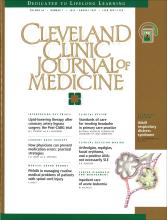Index by author
Alarcon, Graciela S.
- You have accessArthralgias, myalgias, facial erythema, and a positive ANA: not necessarily SLEGraciela S. Alarcon, MD, MPHCleveland Clinic Journal of Medicine July 1997, 64 (7) 361-364;
Physicians frequently see patients with vague musculoskeletal complaints and intermittent rashes who are thought to have a connective tissue disease.
Cady, Roger K.
- You have accessNational headache foundationGlen D. Solomon, MD, Roger K. Cady, MD, Jack A. Klapper, MD and Robert E. Ryan, MDCleveland Clinic Journal of Medicine July 1997, 64 (7) 373-383;
These guidelines, developed by the National Headache Foundation, target diagnosis, therapy and referral.
Clough, John D.
- You have accessDear ColleagueJohn D. Clough, MDCleveland Clinic Journal of Medicine July 1997, 64 (7) 345;
Frost, Frederick
- You have accessPitfalls in managing routine medical problems of patients with spinal cord injuryFrederick Frost, MDCleveland Clinic Journal of Medicine July 1997, 64 (7) 352-354;
Physicians caring for patients with spinal cord injury need to know how to apply management strategies uniquely appropriate in these patients.
Hoffman, Gary S.
- You have accessArthralgias, myalgias, facial erythema, and a positive ANA: not necessarily SLEGraciela S. Alarcon, MD, MPHCleveland Clinic Journal of Medicine July 1997, 64 (7) 361-364;
Physicians frequently see patients with vague musculoskeletal complaints and intermittent rashes who are thought to have a connective tissue disease.
Hoogwerf, Byron J.
- You have accessLipid-lowering therapy after coronary artery bypass surgery: the Post-CABG trialWilliam J. Stewart, MD and Byron J. Hoogwerf, MDCleveland Clinic Journal of Medicine July 1997, 64 (7) 347-351;
The Post-CABG trial is an important milestone that demonstrates the benefits of treating hypercholesterolemia in patients who have had bypass surgery.
Jones, Edward H.
- You have accessHow physicians can prevent medication errors: practical strategiesEdward H. Jones, PharmD and Rex Speerhas, RPHCleveland Clinic Journal of Medicine July 1997, 64 (7) 355-359;
Until improved systems are in place to detect and analyze medication errors, physicians can prevent many serious medication errors by observing some basic safety practices.
Kalaycio, Matt
- You have accessInpatient management of acute leukemiaMatt Kalaycio, MDCleveland Clinic Journal of Medicine July 1997, 64 (7) 385-389;
In treating acute leukemia, there are four medical emergencies that require immediate attention: infection, hemorrhage, hyperleukocytosis, and tumor lysis syndrome.
Klapper, Jack A.
- You have accessNational headache foundationGlen D. Solomon, MD, Roger K. Cady, MD, Jack A. Klapper, MD and Robert E. Ryan, MDCleveland Clinic Journal of Medicine July 1997, 64 (7) 373-383;
These guidelines, developed by the National Headache Foundation, target diagnosis, therapy and referral.
Markman, Maurie
- You have accessInpatient management of acute leukemiaMatt Kalaycio, MDCleveland Clinic Journal of Medicine July 1997, 64 (7) 385-389;
In treating acute leukemia, there are four medical emergencies that require immediate attention: infection, hemorrhage, hyperleukocytosis, and tumor lysis syndrome.



